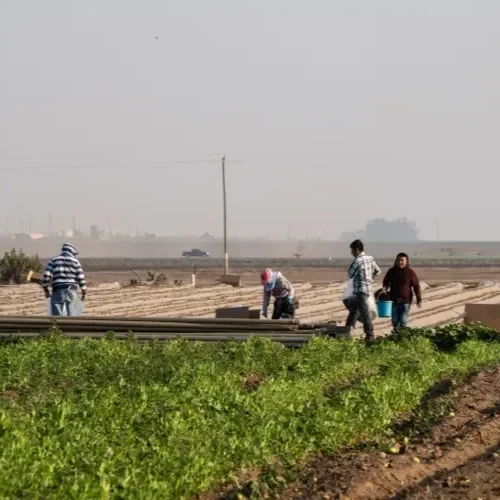Fertilizer costs are having a bigger and bigger impact on farm budgets. In the lead-up to the 2022 crop year, fertilizer prices surged to record highs, driven by tight global supplies, energy shocks and trade disruptions. That period became a turning point in how farmers and policymakers thought about farm input risks. Fertilizer prices eased somewhat in 2023 and 2024 as energy markets stabilized and supply chains recovered, but price volatility is at the forefront once again.
Read MoreCorn production is up, while soybean and cotton production is down from 2024, according to the Crop Production report issued by USDA’s National Agricultural Statistics Service (NASS). Corn production is up 13% from last year, forecast at 16.8 billion bushels; soybean growers are expected to decrease their production 2% from 2024, forecast at 4.30 billion bushels; cotton production is down 8% from 2024 at 13.2 million 480-pound bales.
Read MoreThe Loreauville Canal Control Structure, a decades-old piece of infrastructure in Iberia Parish, has recently undergone a major rehabilitation project to safeguard the region’s freshwater supply.
Originally built to prevent saltwater intrusion, the structure plays a key role in allowing the Teche-Vermilion Fresh Water District to manage the freshwater that flows into Bayou Teche and through the parish’s waterways.
Read MoreAfter four people have died and several others became sick after eating raw Gulf oysters contaminated with the flesh-eating bacteria Vibrio vulnificus, the LSU Ag Center is urging you to use caution before eating raw oysters. Seafood extension specialist Evelyn Watts says the risk is especially high during the summer.
“Oysters are affected by Vibrio vulnificus. That is a pathogen that mostly grows in brackish or salt water. Mostly, it’s going to be in the warm months,” Watts explained.
Read MoreThis month’s 2025/26 U.S. corn outlook indicates greater supplies, larger exports, and a slight reduction in ending stocks. Projected beginning stocks for 2025/26 are 20 million bushels higher based on a lower use forecast for 2024/25, with reductions in imports and corn used for ethanol partially offset by an increase in exports. Corn production for 2025/26 is forecast at 16.8 billion bushels, up 72 million from last month as a 2.1-bushel reduction in yield to 186.7 bushels per acre is more than offset by a 1.3 million acre increase in harvested area to 90.0 million acres.
Read MoreA silent crisis is unfolding across America’s heartland.
The veterinarians tasked with protecting the nation’s livestock, and by extension, its food supply, are a dwindling force, creating a critical gap in the first line of defense against disease and food insecurity.
For Dr. Rachel Miner, a mixed-animal veterinarian in eastern Kansas, a 60-mile drive to a farm call isn’t unusual. It has become a reality of the job.
Read MoreMonitoring Non-Real Estate Farm Debt provides insight into debt health. At the time of this article, harvesting is on many people’s minds, producers are baling hay, tariffs are a constant conversation, and livestock prices are at all-time highs.
Read MoreFor those who remember taking part in the football game day tailgating cooking competition between Arkansas and Louisiana known as the “Rice Bowl,” mark your calendars because: it’s back! Plan to be on the campus of the University of Louisiana Monroe (ULM) on September 27 when the ULM Warhawks host the Arkansas State University (ARST) Red Wolves in Malone Stadium in a Sun Belt Conference showdown that promises to be delicious, no matter which team wins.
Read MoreU.S. Secretary of Agriculture Brooke L. Rollins today announced eligible livestock producers will receive disaster recovery assistance through the Emergency Livestock Relief Program for 2023 and 2024 Flood and Wildfire (ELRP 2023 and 2024 FW) to help offset increased supplemental feed costs due to a qualifying flood or qualifying wildfire in calendar years 2023 and 2024. The program is expected to provide approximately $1 billion in recovery benefits. Sign-up begins on Monday, September 15. Livestock producers have until October 31, 2025, to apply for assistance.
Read MoreAn ag economist at Ohio State University says the ag trade deficit reached its peak in July and it’s spurring concerns about the future of U.S. ag exports.
Read MoreThe third annual Calf Roping on the Bluff, hosted by Southern University Ag Center, is coming up at the end of September.
Read MoreLouisiana produces 850 million pounds of seafood each year, according to the Louisiana Seafood Promotion & Marketing Board. Much of that includes crustaceans like crawfish, shrimp, and crab.
Read MoreThe Trump administration is making another run at reforming the way H-2A minimum wage rates for farmworkers are set in a manner that could provide some relief to farmers during a time of continued uncertainty about workers who are in the country illegally.
Read MoreA Roseland, Louisiana, resident has filed a lawsuit against nearby Smitty’s Supply Inc. following the Aug. 22 explosion and subsequent fire at the petroleum products facility that took more than two weeks to extinguish.
Read MoreThe rice delphacid is wreaking havoc across rice fields in Texas and has recently been spotted in Arkansas and Louisiana. The pest is also a vector of rice hojo blanca virus, which can damage rice plants above and beyond that caused by the insect directly.
Read More














